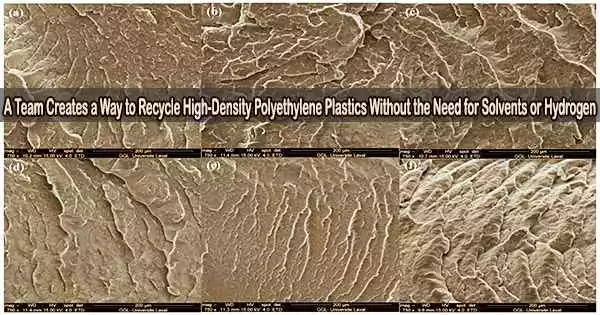High-density polyethylene (HDPE) is a type of thermoplastic polymer made from ethylene monomers. It is known for its high strength-to-density ratio, making it a popular choice for a wide range of applications. HDPE can be processed using various methods, including injection molding, blow molding, extrusion, and rotational molding, allowing for a wide range of products to be manufactured using this versatile plastic.
A research team led by Prof. Zeng Jie from the University of Science and Technology of China (USTC) of the Chinese Academy of Sciences (CAS), has made a significant breakthrough in the field of plastic upcycling.
A novel dehydroaromatization and hydrogenolysis tandem strategy is presented in their study, “Solvent and Hydrogen-Free Catalytic Conversion of High-Density Polyethylene Plastics,” to transform high-density polyethylene (HDPE) plastics into useful cyclic hydrocarbons without the use of solvents or hydrogen.
The findings were published in Nature Nanotechnology.
Due to its robust chemical structure, polyethylene, one of the most widely used polymers, presents difficulties in terms of natural breakdown. Recycling techniques for used polyethylene plastics reduce pollution while also providing advantages economically.
The research team aimed to treat waste HDPE plastics as a solid-petroleum raw material through environmentally friendly catalytic conversion, thereby producing downstream petroleum-based chemical products. They did this by drawing inspiration from two processes in the petroleum industry, namely catalytic reforming of short-chain gasoline fractions and hydrocracking of heavy oils.
The research team concentrated on catalytic reforming of short-chain gasoline fractions to obtain higher-value cyclic hydrocarbons, which consumes hydrogen, and hydrocracking of heavy oils to produce short-chain hydrocarbons, which consumes hydrogen. Both of these processes are used in the petroleum industry.
Building upon these processes, the research team devised a “hydrogen-breathing” strategy for degrading high-density polyethylene (HDPE) plastics. They created a molecular sieve-loaded metallic ruthenium catalyst (Ru/HZSM-5) that helps the plastic dehydrogenate into cyclic hydrocarbons while simultaneously “breathing out” hydrogen.
The released hydrogen is simultaneously “breathed in” by the plastic as it cracks and changes into short-chain hydrocarbons.
The research team then looked at the high-density polyethylene polymers’ upcycling reaction routes. They carried out catalytic studies on the recycling of HDPE plastics with various ruthenium metal molecular sieve loadings, and they looked at how the molecular sieve holes affected the reaction.
The findings demonstrate that the HZSM-5 molecular sieve has a moderate pore size, which prevents the buildup of thick deposits of carbon and cyclic aromatic hydrocarbons while also ensuring the smooth desorption of cyclic hydrocarbons, thereby ensuring the continuity and stability of the catalytic reaction.
Ru/HZSM-5 catalysts have a very good cyclic stability, and are also suitable for different types of polyethylene plastics.
This study makes a substantial contribution to the upcycling of plastic and holds enormous potential for the long-term sustainability of our civilization. This study adds to the ongoing efforts to eliminate plastic waste and advance a more sustainable future by offering a novel method for converting HDPE plastics into worthwhile cyclic hydrocarbons.
















